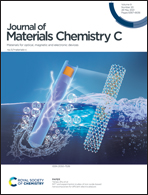Comparative degradation analysis of V2O5, MoO3 and their stacks as hole transport layers in high-efficiency inverted polymer solar cells
Abstract
In this work, a comparative degradation analysis of high-efficiency inverted organic solar cells (iOSCs) is presented, with the PTB7-Th:PC70BM blend as the active layer and hole transport layers (HTLs), of V2O5, MoO3 and their stacks. Five groups of iOSCs, were fabricated with V2O5 (3 nm), V2O5/MoO3 (3/1 nm), V2O5/MoO3 (3/2 nm), V2O5/MoO3 (3/5 nm) and MoO3 (10 nm), respectively. The performance parameters obtained from illuminated J–V curves of the devices were analyzed. The long-term operational stability of encapsulated iOSCs is studied following the ISOS-D1 protocols for 19 600 h. The maximum PCE obtained using stacks of V2O5/MoO3 (3/1 nm) is 10.58%. The best stability was obtained for devices using 10 nm MoO3 as the HTL, for which after 19 600 h, the PCE reduced to 51%. The cell using 3 nm V2O5 degraded to 50% of its initial PCE (T50) after only 775 hours. The use of stacks of V2O5/MoO3 (3/1 nm), V2O5/MoO3(3/2 nm), V2O5/MoO3 (3/5 nm), increased the long-term stability of iOSCs, with T50 values equal to 3140 h, 4865 h, and 6808 h, respectively. Our study provides the details of the causes of the differences in behavior observed for the different materials used as HTLs. Although the physical degradation mechanism seems to be the same, the intensity is lower as the MoO3 thickness increases, which acts as a diffusion barrier reducing the diffusion rate of O2 and H2O toward the active layer. The impedance spectroscopy measurements confirm that, in this study, the degradation of the active layer is the main cause of decrease in performance of the device.



 Please wait while we load your content...
Please wait while we load your content...